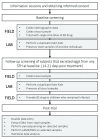Piloting a surveillance system to monitor the global patterns of drug efficacy and the emergence of anthelmintic resistance in soil-transmitted helminth control programs: a Starworms study protocol
- PMID: 32266328
- PMCID: PMC7120503
- DOI: 10.12688/gatesopenres.13115.1
Piloting a surveillance system to monitor the global patterns of drug efficacy and the emergence of anthelmintic resistance in soil-transmitted helminth control programs: a Starworms study protocol
Abstract
To eliminate soil-transmitted helminth (STH) infections as a public health problem, the administration of benzimidazole (BZ) drugs to children has recently intensified. But, as drug pressure increases, the development of anthelmintic drug resistance (AR) becomes a major concern. Currently, there is no global surveillance system to monitor drug efficacy and the emergence of AR. Consequently, it is unclear what the current efficacy of the used drugs is and whether AR is already present. The aim of this study is to pilot a global surveillance system to assess anthelmintic drug efficacy and the emergence of AR in STH control programs. For this, we will incorporate drug efficacy trials into national STH control programs of eight countries (Bangladesh, Cambodia, Lao PDR, Vietnam, Ghana, Rwanda, Senegal and a yet to be defined country in the Americas). In each country, one trial will be performed in one program implementation unit to assess the efficacy of BZ drugs against STHs in school-aged children by faecal egg count reduction test. Stool samples will be collected before and after treatment with BZs for Kato-Katz analysis and preserved to purify parasite DNA. The presence and frequency of known single nucleotide polymorphisms (SNPs) in the β-tubulin genes of the different STHs will subsequently be assessed. This study will provide a global pattern of drug efficacy and emergence of AR in STH control programs. The results will provide complementary insights on the validity of known SNPs in the ß-tubulin gene as a marker for AR in human STHs as well as information on the technical and financial resources required to set up a surveillance system. Finally, the collected stool samples will be an important resource to validate different molecular technologies for the detection of AR markers or to identify novel potential molecular markers associated with AR in STH.
Keywords: Kato-Katz thick smear; Soil-transmitted helminths; anthelmintic drug resistance; benzimidazoles; egg reduction rate; loop-mediated isothermal amplification; next generation sequencing; preventive chemotherapy; single nucleotide polymorphisms.
Copyright: © 2020 Vlaminck J et al.
Conflict of interest statement
No competing interests were disclosed.
Figures
References
-
- World Health Organization: Helminth control in school-age children: a guide for managers of control programmes. Geneva, Switserland.2011. Reference Source
-
- World Health Organization: Schistosomiasis and soil-transmitted helminthiases: numbers of people treated in 2017. Weekly epidemiological record. 2018;93:681–92. Reference Source
-
- World Health Organization: Soil-transmitted helminthiases: eliminating soil-transmitted helminthiases as a public health problem in children: progress report 2001-2010 and strategic plan 2011-2020. Geneva, Switserland.2012. Reference Source
-
- World Health Organization: 2030 targets for soil-transmitted helminthiasis control programmes. Geneva, Switserland.2019. Reference Source
-
- van Wyk JA: Refugia--overlooked as perhaps the most potent factor concerning the development of anthelmintic resistance. Onderstepoort J Vet Res. 2001;68(1):55–67. - PubMed
Grants and funding
LinkOut - more resources
Full Text Sources
Research Materials


